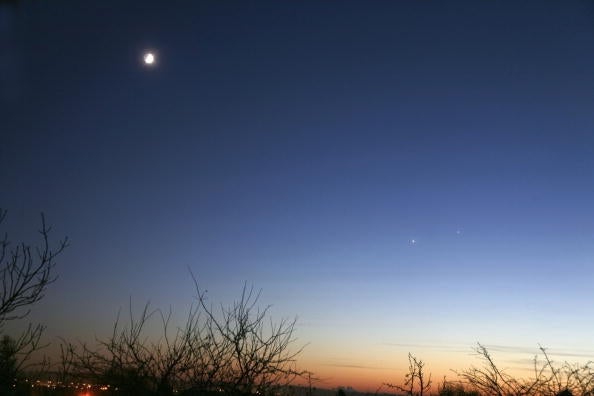Jupiter and Venus put on spectacular early-morning planetary display
Planets orbit 416 million miles apart but appear much closer

Venus and Jupiter appeared to rise very close together early Monday morning, offering stargazers an amazing and rare sight.
The planets rose on an almost identical path – just 0.3 degrees apart – when viewed from Earth, although they orbit the sun more than 400 million miles away from each other.
Venus and Jupiter, the two brightest planets in the solar system apart from the moon and the sun, stayed low on the horizon and were visible in the eastern sky. The planets could be seen by the naked eye, although binoculars offered a clearer view and maybe even of Jupiter’s moons.
The celestial conjunction occurs when the planets share the same east to west longitude in the sky, according to Space.com.
Earthsky.com defines astronomical conjunctions as "the close approach of two or more solar system bodies or a close approach of a single solar system body with another object in the sky."
Stargazers will have another chance to glimpse the rare phenomenon on Tuesday morning, but the planets will not be so close together.
Those in the UK – the Northern Hemisphere – are likely to get the best views, if they have not already caught a glimpse.
On the morning of 13 November, Venus rose at 5.56am in the UK, and Jupiter rose two minutes later, with conjunction occurring at 6.05am.
Both were visible for around 30 minutes, until the sunrise blocked out the planets.
They only rose around 11 degrees above the horizon, so viewers would have needed to find a high spot with a clear view.
Starwatchers are advised to travel to a rural location to see the display, away from light pollution.
Although viewing conditions were clear on Monday morning, the Met Office forecasts light rain overnight and cloud across much of the UK into Tuesday.
Next year there will be 12 celestial conjunctions between different planets. For example, on 6 January, Mars and Jupiter will be only 0.2 degrees apart.
Join our commenting forum
Join thought-provoking conversations, follow other Independent readers and see their replies
Comments
Bookmark popover
Removed from bookmarks